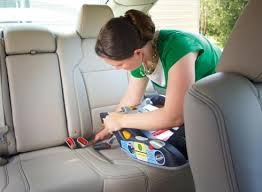Defensive Driving Tip #67: Keep Your Child Safe in the Center
This may come as a surprise if you’re not a parent, but We teach in defensive driving class that kids aren’t born with perfectly formed and completed bodies! Their skeletal structure, for one thing, isn’t fully grown and “put together” at birth. Their bones aren’t as supportive and rigid as yours — and crash forces and impacts can hurt them in different ways than they hurt us. It is therefore important kids get a little more help from their parents or caregivers in terms of how and where they sit in the vehicle.
The Next thing we teach in defensive driving class is that the safest place for a child is in the center of the rear seat, in a protective seat (for as long as you can keep them in it). The front-right seat in a left-hand drive vehicle is not a safe place for a smaller child (or maybe not even for you). The front-right seat in an American vehicle has sometimes been referred to as the “suicide” chair, although the driver’s side is probably even a bit more dangerous, from a hazards point of view (given that the most common fatal collision in city driving is a left turn collision). But given a choice of evasive actions, a driver will instinctually turn away from a collision — leaving it more likely the damage will be to the right front side. Couple that with the reality that a child doesn’t “fit” the passive safety equipment at that location and you increase the likelihood of injury. Both seat belts and air bags can injure the occupant if they do not fit correctly. The safer choice is to put all children in the back seat. Let me state this more clearly — children should NEVER be seated behind an armed air bag in the front-right seat. If the air bag fires, the child can be injured or even killed, the seat belt system may not secure the child well enough, and the chances of impact on that side and area are increased. If you’ve been reading my rules, you know I rarely ever say never.
Another thing we teach in defensive driving class is that most vehicles have center seat belts. Placing the child and/or the safety restraint seat in the center isolates the child from the potential of rear-door side-impact injuries. Make sure you belt the seat in properly and that it fits the seat at that location. Once a child is about five years old, many state laws allow them to be seat belted rather than in a child restraint seat. Again, keep the kid in the restraint seat as long as they’ll let you. As long as the seat fits them correctly, they are safer there.
Some states may still have a law that the child restraint seat is to be used until a specific age or weight. If you have a child that is heavier than other children of the same age, you might think that child can be taken out of the child seat. For example, in Arizona, the child restrain law requires children up to 5 to be in a child restraint system, children younger than 8 years old or less than 4 feet 9 inches tall to sit in a proper child safety seat, such as a booster seat, when riding in a vehicle. Remember what I said about kids’ bone structure not being fully developed? That doesn’t happen until they are between 4 and 5 years old. If a child is 2 ½ , but weighs more than 40 pounds, he needs to be in a restraint seat even more because of the extra stress and strain on his undeveloped bones. Many states are therefore changing these laws to simply state an age limit, rather than age or weight. If you get a ticket take our defensive driving course 2passdd.com
